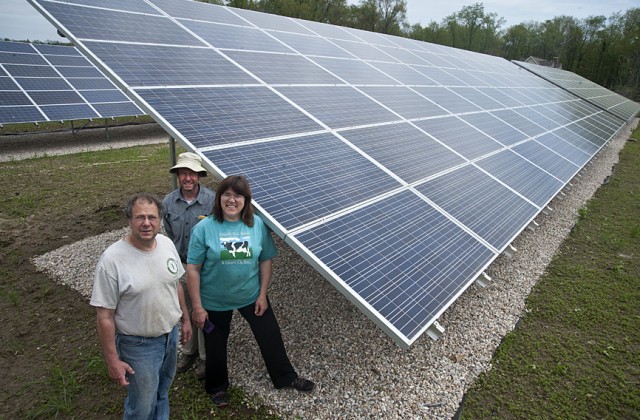Solar Generation On The Rise
Area Residents Find Solar Affordable
By Bob Bumcrot
Driving along Route 44 through East Canaan, it’s hard not to notice the large set of solar panels across the road from Freund’s farm: eight big arrays totaling 576 panels on the site of the old Couch farmhouse and barn. The 130-kilowatt installation by PurePoint Energy of Norwalk was the brainchild of Ben Freund, who runs the family farm with his brother, Matthew, inventor of the Cowpot.
“We put the array on some of our least productive land,” said Ben Freund, “and covered about the largest space allowed by farmland regulations.” The array began producing electricity early this year. “It was enough in February to run the whole farm,” said Ben. While he was reluctant to talk about costs, others say that it was in the neighborhood of $400,000 and that it might pay for itself in as little as five years.
It all begins with the sun, which makes up 99.8 percent of the mass of the solar system. Every second it burns five million tons of this mass through nuclear fusion, changing hydrogen to helium and emitting an enormous amount of energy. One-half of one-billionth of this solar energy reaches the earth. About one-half of that is either reflected or absorbed by the atmosphere. Since the industrial revolution, atmospheric absorption of carbon dioxide and other fossil fuel pollutants has increasingly contributed to global warming, sometimes called climate change.
Solar energy that is not absorbed or reflected drenches the earth’s surface during daylight hours with about 700 watts of power per square meter. In just 88 minutes, the energy reaching the earth equals what humankind uses in a year. In less than five days, that energy equals all proven reserves of coal, oil and natural gas in the world. One one-thousandth of this energy is six times all energy now being used. None of this energy produces pollution.
Is there a way to use solar energy to significantly reduce fossil fuel consumption? Until the late twentieth century the answer was “theoretically, yes.” But today the economically advantageous, efficient answer is, simply, “yes.”
Some commercial solar generation facilities use concentrated solar power technology, in which mirrors and lenses, usually in a desert environment, focus sunlight on a boiler that drives a generator. For home and farm use, solar voltaic cells, often called solar panels, are used.
The early era of solar panels is now over. “The technology is in place,” said Norfolk resident Tom Strumolo, a national authority on energy efficiency. Since 1980 the cost of solar cells has fallen exponentially, using that term accurately, from $24 per watt to well below $3. It has dropped 60 percent in the last 18 months and continues to fall. Moreover, state subsidies for panel installation together with a mandate that public utilities buy surplus electricity from solar home generation add to the attraction. Strumolo has personally installed a solar panel system on the roof of his barn along Grantville Road.
For those who object to the appearance of rooftop panels, there are roll-out panels, which give the appearance of a dark steel roof. These can be seen at the Johnson home on North Street and the Steele home on Ashpohtag Road.
While all the installations mentioned above were purchased and are maintained by the property owners, there is another approach to home generation: leasing. Several Norfolk residents, among them the Whalens, are considering proposals from Solar City. This firm, founded by billionaire entrepreneur Elon Musk, will install and maintain a rooftop system for 20 years at no cost to the homeowner, who then contracts to buy the electricity from Solar City at well below the current CL&P rate. This company owns 30 percent of the market and claims to be approaching one million customers across the country, with one enrolled every four minutes. There are also many smaller companies, some in this region, that offer leasing plans.
The choice of whether to buy or lease is a rather complex one, involving alternative investments and risk analysis. For example, since a solar panel produces direct current, it must be run through an inverter to convert it to alternating current that can be fed through the meter. An inverter may not last twenty years and costs quite a lot. Under a lease agreement the inverter would be replaced at no charge. The rate of increase in generation charges by CL&P should be estimated and compared to the increase rates in the lease contract. (CL&P was recently granted an 8% hike.) Many homeowners consult a finance professional before making a decision to buy or lease.
It should come as no surprise that utility and energy companies are furiously battling the oncoming tide of home generation. For example, Massachusetts allows the owner of an appropriate site to set up an array for herself and neighbors. A similar proposal for Connecticut has somehow never gotten out of committee.
On a lighter note, readers are urged to take a look at the video presentation of a startup company called Solar Roadways of Sandpoint, Idaho. They have developed glass solar panels that can be installed in highways and parking lots, are unbreakable and reduce road freezing. If extremely widely used, the panels could power the whole nation. The video is at www.solarroadways.com/introduction.
Finally, we return to the sun. Scientists and engineers have for decades pursued the holy grail of a controlled fusion reaction: little suns here on earth. By far the most important experiment underway is ITER, a multi-billion-dollar, multi-nation project in southern France, without doubt the most complicated machine ever attempted. We wish them luck.
Photo by Bruce Frisch.

